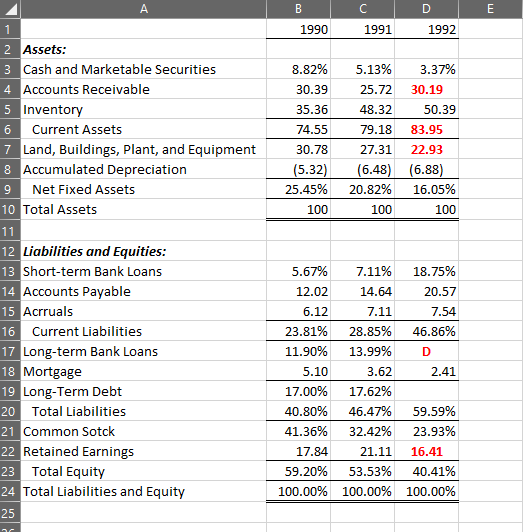Question
Garden State Container Corporation manufactures boxes and other containers primarily for farm products. More than 85 percent of the companys sales come from the northeastern
Garden State Container Corporation manufactures boxes and other containers primarily for farm products. More than 85 percent of the companys sales come from the northeastern part of the United States, especially Pennsylvania, New Jersey, New York, and Maryland, although the companys patented egg cartons are distributed throughout the United States. Jim Jackson, the founder and president, recently received a call from Martha Menendez, vice president of Atlantic First National Bank. Menendez told him that a negative report had been generated by the banks computerized analysis system; the report showed that Garden States financial position was bad and getting worse.
The bank requires quarterly financial statements from each of its major loan customers. Information from these statements is fed into the computer, which then calculates key ratios for each customer and charts trends in these ratios. The system also compares the statistics for each company with the average ratios of other firms in the same industry and against any protective covenants in the loan agreements. If any ratio is significantly worse than the industry average, reflects a marked adverse trend, or fails to meet contractual requirements, the computer highlights the deficiency.
The latest report on Garden State revealed a number of adverse trends and several potentially serious problems (see Tables 1 through 6 for Garden States historical financial statements). Particularly disturbing were the 1992 current, quick, and debt ratios, all of which failed to meet the contractual limits of 2.0, 1.0, and 55 percent, respectively. Technically, the bank had a legal right to call all the loans it had extended to Garden State for immediate repayment and, if the loans were not repaid within ten days, to force the company into bankruptcy.
Martha hoped to avoid calling the loans if at all possible, as she knew this would back Gar-den State into a corner from which it might not be able to emerge. Still, her own banks examiners had recently become highly sensitive to the issue of problem loans, because the recent spate of bank failures had forced regulators to become more strict in their examination of bank loan portfolios and to demand earlier identification of potential repayment problems.
One measure of the quality of a loan is the Altman Z score, which for Garden State was 3.04 for 1992, slightly below the 3.20 minimum that Marthas bank uses to differentiate strong firms with little likelihood of bankruptcy in the next two years from those deemed likely to go into default. This will put the bank under increased pressure to reclassify Garden States loans as problem loans, to set up a reserve to cover potential losses, and to take whatever steps are necessary to reduce the banks exposure. Setting up the loss reserve would have a negative effect on the banks profits and reflect badly on Marthas performance.
To keep Garden States loan from being reclassified as a problem loan, the Senior Loan Committee will require strong and convincing evidence that the companys present difficulties are only temporary. Therefore, it must be shown that appropriate actions to overcome the problems have been taken and that the chances of reversing the adverse trends are realistically good. Martha now has the task of collecting the necessary information, evaluating its implications, and preparing a recommendation for action.
The recession that plagued the U.S. economy in the early 1990s caused severe, though hopefully temporary, problems for companies like Garden State. On top of this, disastrous droughts for two straight summers had devastated vegetable crops in the area, leading to a drastic curtailment of demand for produce shipping containers. In light of the softening demand, Garden State had aggressively reduced prices in 1991 and 1992 to stimulate sales. Higher sales, the company believed, would allow it to realize greater economies of scale in production and to ride the learning, or experience, curve down to a lower cost position. Garden States management had full confidence that normal weather and national economic policies would revive the ailing economy and that the downturn in demand would be only a short-term problem. Consequently, production continued unabated, and inventories increased sharply.
In a further effort to reduce inventory, Garden State relaxed its credit standards in early 1992and improved its already favorable credit terms. As a result, sales growth did remain high by industry standards through the third quarter of 1992, but not high enough to keep inventories from continuing to rise. Further, the credit policy changes had caused accounts receivable to increase dramatically by late 1992.
To finance its rising inventories and receivables, Garden State turned to the bank for a long-term loan in 1991 and also increased its short-term credit lines in both 1991 and 1992. However, this expanded credit was insufficient to cover the asset expansion, so the company began to delay payments of its accounts payable until the second late notice had been received. Management realized that this was not a particularly wise decision for the long run, but they did not think it would be necessary to follow the policy for very longthe 1992 summer vegetable crop looked like a record breaker, and it was unlikely that a severe drought would again hurt the crop. They also predicted that the national economy would pull out of the weak growth scenario in late 1992. Thus, the company was optimistic that its stable and profitable markets of the past would soon reappear.
After Marthas telephone call, and the subsequent receipt of a copy of the banks financial analysis of Garden State, Jim began to realize just how precarious his companys financial position had become. As he started to reflect on what could be done to correct the problems, it suddenly dawned on him that the company was in even more trouble than the bank imagined. Jim had recently signed a firm contract for a plant expansion that would require an additional $12,750,000 of capital during the first quarter of 1993, and he had planned to obtain this money with a short-term loan from the bank to be repaid from profits expected in the last half of 1993 as a result of the expansion. Innis view, once the new production facility went online, the company would be able to increase output in several segments of the shipping container market. It might have been possible to cut back on the expansion plans and to retrench, but because of the signed construction contracts and the cancellation charges that would be imposed if the plans were canceled, Jim correctly regards the$12,750,000 of new capital as being essential for Garden States very survival.
Jim quickly called his senior management team in for a meeting, explained the situation, and asked for their help in formulating a solution. The group concluded that if the companys current business plan were carried out, Garden States sales would grow by 10 percent from 1992 to 1993 and by another 15 percent from 1993 to 1994. Further, they concluded that Garden State should reverse its recent policy of aggressive pricing and easy credit, returning to pricing that fully covered costs plus normal profit margins and to standard industry credit practices. These changes should enable the company to reduce the cost of goods sold from over 85 percent of sales in 1992 to about 70 percent in 1993 and then to 60 percent in 1994. Similarly, the management group felt that the company could reduce administrative and selling expenses from almost 9 percent of sales in 1992 to 8 percent in 1993 and then to 7.5 percent in 1994. Significant cuts should also be possible in miscellaneous expenses, which should fall from 2.92 percent of 1992 sales to approximately 1.75 percent of sales in 1993 and to 1.25 percent in 1994. These cost reductions represented trimming the fat, so they were not expected to degrade the quality of the firms products or the effectiveness of its sales efforts. Further, to appease suppliers, future bills would be paid more promptly, and to convince the bank how serious management is about correcting the companys problems, cash dividends would be eliminated until the firm regains its financial health.
Assume that Jim has hired you as a consultant to first verify the banks evaluation of the companys current financial situation and then to put together a forecast of Garden States expected performance for 1993 and 1994. Jim asks you to develop some figures that ignore the possibility of a reduction in the credit lines and that assume the bank will increase the line of credit by the$12,750,000 needed for the expansion and supporting working capital. Also, you and Jim do not expect the level of interest rates to change substantially over the two-year forecast period; how-ever, you both think that the bank will charge 12 percent on both the additional short-term loan, if it is granted, and on the existing short-term loans, if they are extended. The assumed 40 percent combined federal and state tax rate should also hold for two years. Finally, if the bank cooperates, and if Jim is able to turn the company around, the P/E ratio should be 12 in 1993 and should rise to 14in 1994.
Complete the 1992 column. If you are using the Lotus Model, use it to complete the table.

Step by Step Solution
There are 3 Steps involved in it
Step: 1

Get Instant Access to Expert-Tailored Solutions
See step-by-step solutions with expert insights and AI powered tools for academic success
Step: 2

Step: 3

Ace Your Homework with AI
Get the answers you need in no time with our AI-driven, step-by-step assistance
Get Started


